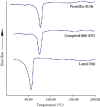Experimental Study on the Resistance of Synthetic Penicillin Solid Lipid Nanoparticles to Clinically Resistant Staphylococcus aureus
- PMID: 34804197
- PMCID: PMC8601793
- DOI: 10.1155/2021/9571286
Experimental Study on the Resistance of Synthetic Penicillin Solid Lipid Nanoparticles to Clinically Resistant Staphylococcus aureus
Abstract
Background: With the increasing resistance of antibiotics to bacteria, new and effective methods are needed to transform existing antibiotics to solve the problem of long development cycles for new drugs. The antibiotic nanodelivery system has proven to be a promising strategy.
Aim: The purpose of this study is to synthesize penicillin solid lipid nanoparticles (penicillin SLNs) to enhance the antibacterial activity of penicillin against drug-resistant Staphylococcus aureus.
Materials and methods: Penicillin SLNs were synthesized. And particle size, the polydispersity index (PI), and zeta potential (ZP) of penicillin SLNs were measured. The surface morphology of penicillin SLNs was observed using a transmission electron microscope.
Results: The particle size of penicillin SLNs is 112.3 ± 11.9 nm, the polydispersity index (PI) and zeta potential (ZP) of penicillin SLNs are 0.212 ± 0.03 and -27.6 ± 5.5 mV. The encapsulation efficiency and drug loading were 98.31 ± 1.2% and 4.98 ± 0.05 (%w/w), respectively. Penicillin SLNs had a more significant inhibitory effect on the growth of methicillin-sensitive Staphylococcus aureus (MSSA) after the drug and the bacteria were incubated for 12 hours. The number of MRSA colonies in the penicillin group increased after 12 hours, while the number of MRSA colonies in the penicillin SLNs group did not change significantly.
Conclusion: Penicillin SLNs enhance the ability of penicillin to enter cells and increase the concentration of penicillin in the cell and also extend the residence time of penicillin in the cell. Our findings indicated that penicillin SLNs enhance the inhibitory effect of penicillin on drug-resistant Staphylococcus aureus.
Copyright © 2021 Enliang Zhao et al.
Conflict of interest statement
We declare no conflict of interest.
Figures





References
MeSH terms
Substances
LinkOut - more resources
Full Text Sources
Medical
Research Materials
Miscellaneous

